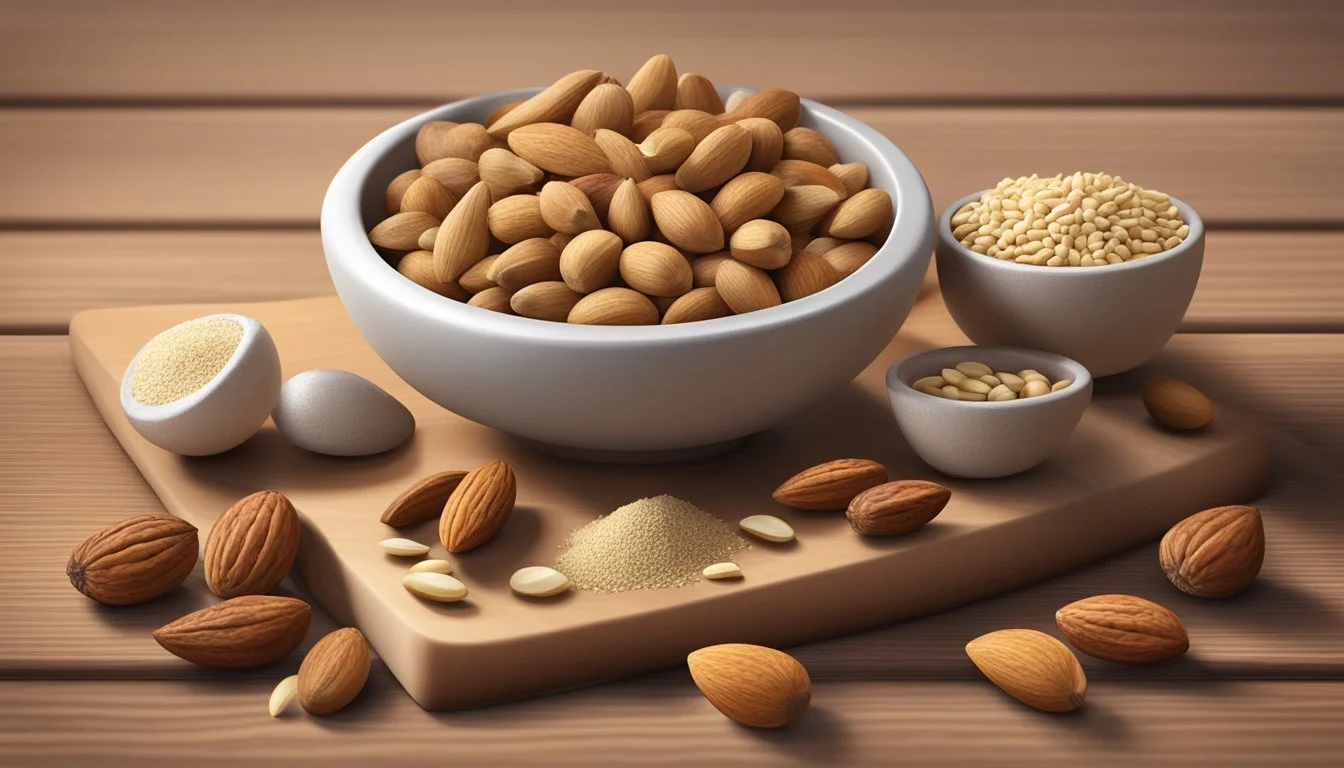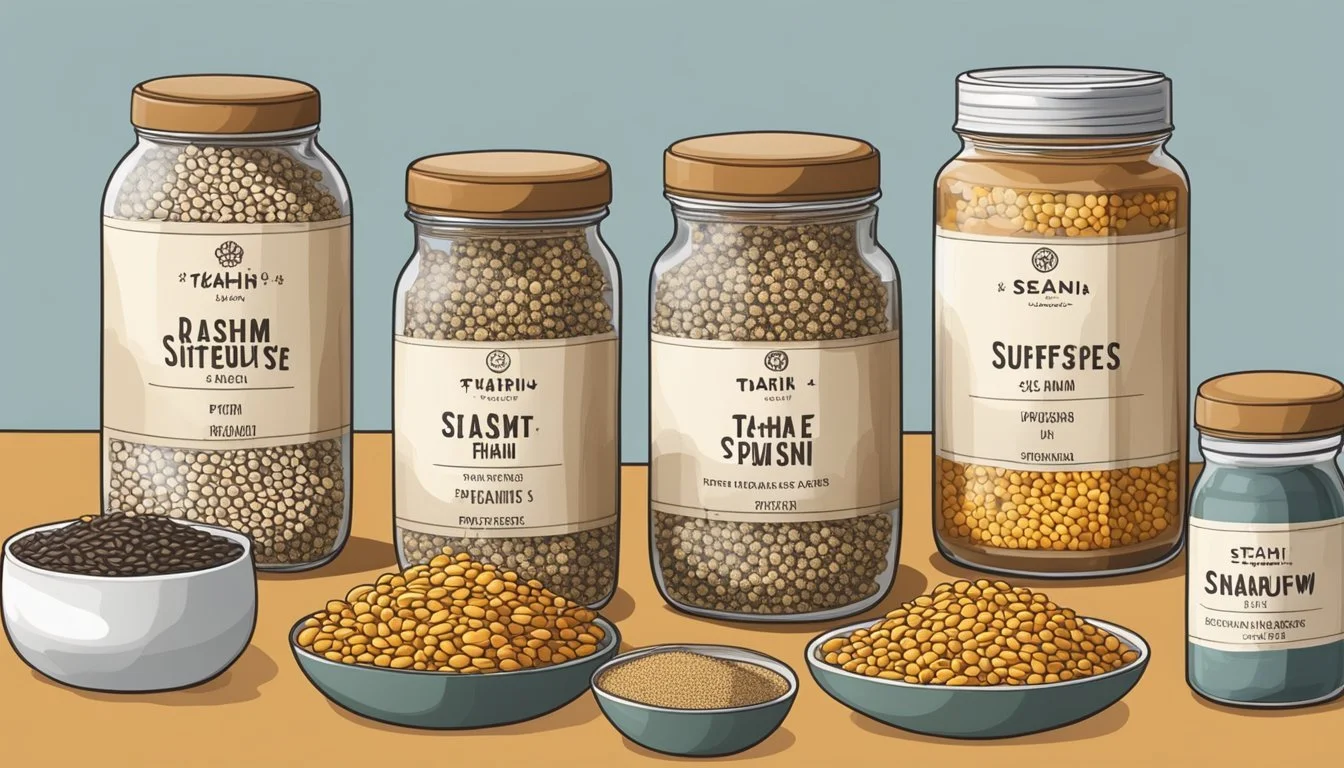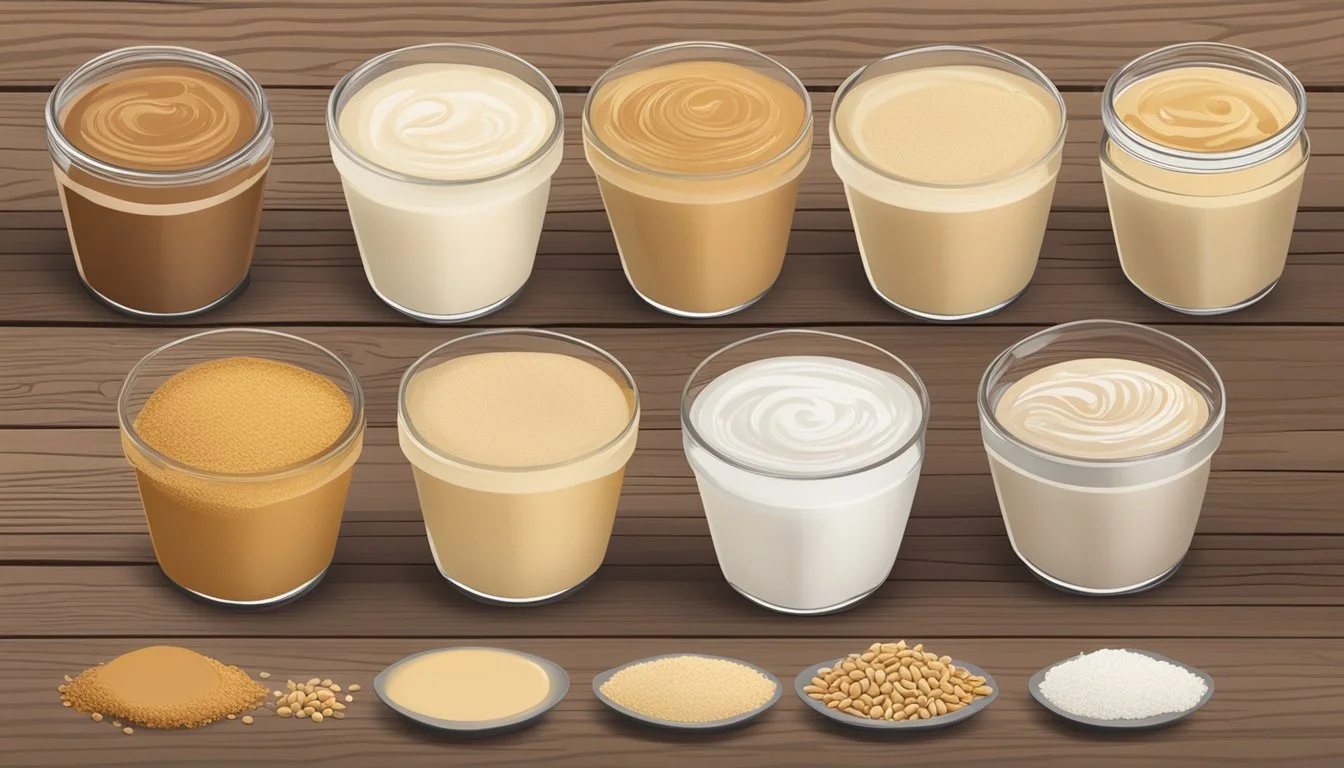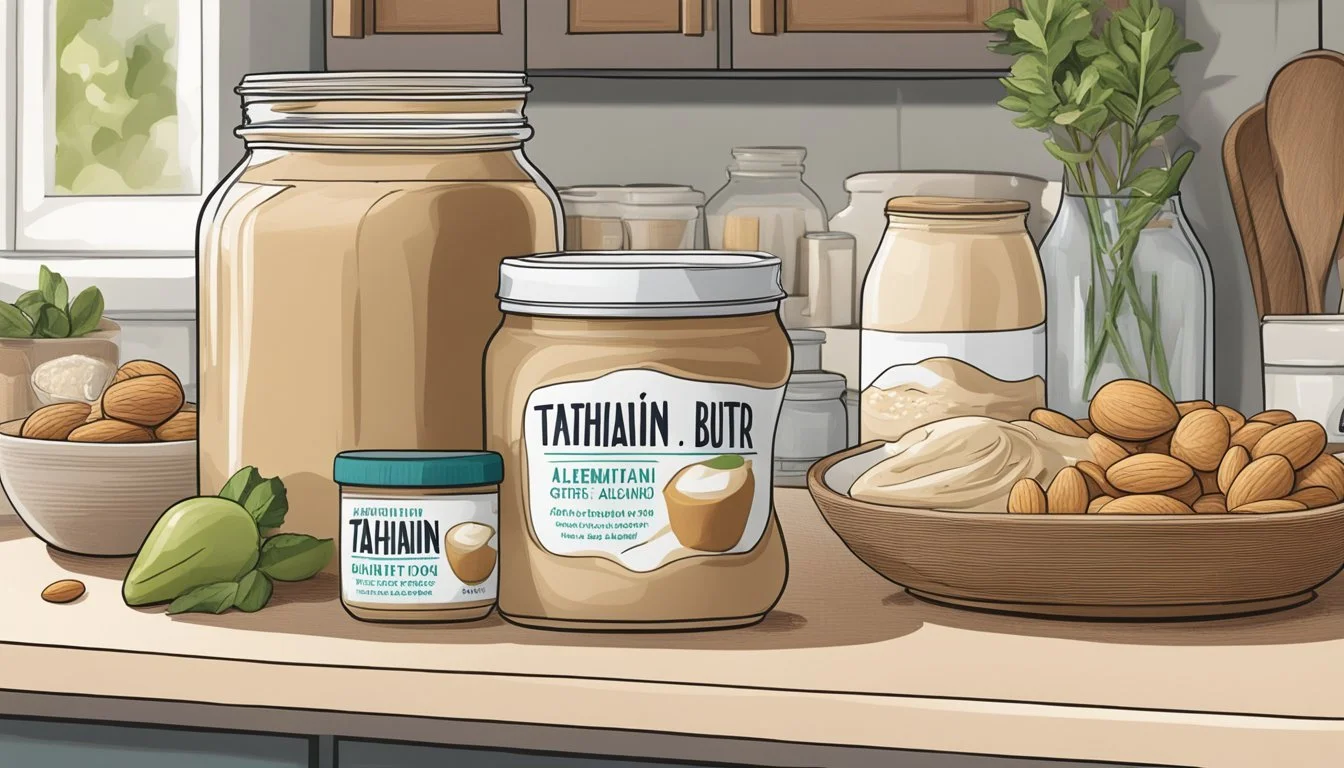Tahini Substitutes
Top Alternatives for Your Recipes
Tahini, a paste made from ground sesame seeds, is a staple ingredient in many Middle Eastern dishes such as hummus and baba ganoush. Its rich, nutty flavor and creamy texture make it versatile in a variety of savory and sweet recipes. However, its distinctive taste and role as an emulsifier can be a challenge to replicate. For those who are unable to use tahini due to dietary restrictions or availability issues, there are several alternative ingredients that can be used to achieve a similar effect.
Substitutes for tahini often include other nut and seed butters such as peanut butter, almond butter, and sunflower seed butter. Each alternative brings its own unique flavor and may work better in certain dishes. Cashew butter, known for its neutral taste, is particularly effective in mimicking tahini's role in sauces, dressings, and dips. Peanut butter, while having a more pronounced flavor, is a common replacement that is widely available and cost-effective.
When seeking a tahini substitute, one must consider the desired outcome in flavor and texture. For instance, sesame oil can provide the sesame flavor but lacks the thickness of tahini, while Greek yogurt offers a creamy base with a tangy twist. In some cases, individuals opt to make their own tahini by blending sesame seeds with a neutral oil for a homemade alternative. Choosing the right substitute will depend on the specific characteristics of tahini that need to be replicated in a given dish.
Understanding Tahini
This section delves into the essence of tahini, a crucial ingredient in many Middle Eastern and Mediterranean dishes, exploring its composition, nutritional value, and culinary roles.
What Is Tahini?
Tahini is a paste made from toasted, ground sesame seeds. Originating from the Middle East, it boasts a creamy texture and a nutty, slightly bitter flavor. Its versatility allows it to adapt to various recipes, enhancing them with its distinctive taste.
Nutritional Profile
Tahini is revered for its rich nutritional content. A tablespoon typically contains:
Calories: Approx. 89
Fat: 8 grams (consisting predominantly of monounsaturated and polyunsaturated fats)
Protein: 2.6 grams
Carbohydrates: 3 grams
Notably, tahini is a good source of essential minerals such as calcium and iron.
Common Uses in Cooking
In cooking, tahini serves multiple purposes. It is a key ingredient in tahini sauce, which is a staple in many Middle Eastern dishes. The sauce pairs well with vegetables, falafel, and grilled meats. Furthermore, tahini is integrated into various Mediterranean spreads like hummus and baba ghanoush, leaning into its rich, full-bodied flavor to elevate these common dishes.
Identifying Substitute Requirements
When looking for a tahini substitute, one must consider the flavor profile, texture, and potential allergy concerns to ensure that the alternative aligns closely with the qualities of traditional tahini.
Desired Flavor Profile
Tahini has a distinctive nutty, slightly bitter taste that is essential in dishes like hummus and various Middle Eastern sauces. The ideal substitute should mimic this flavor to maintain the integrity of the recipe. Nut and seed butters, such as cashew butter, can provide a comparable nuttiness, though often milder.
Texture Considerations
Traditional tahini presents a smooth, paste-like texture that is pivotal for the desired mouthfeel in recipes. A proper substitute should have a similar consistency to blend seamlessly into dishes. Options like almond butter or sunflower seed butter offer a paste-like texture that can approximate tahini when mixed into sauces and dressings.
Allergy Considerations
For individuals with nut allergies, finding a safe tahini substitute is crucial. Nut-free alternatives like sunflower seed butter are viable options. It's important to ensure that the substitute chosen is free from contaminants and has been processed in an allergen-free facility if severe allergies are a concern.
Nut-Based Tahini Substitutes
When seeking a tahini alternative, nut butters offer a convenient and flavorful option. Each type of nut butter brings a unique flavor profile and nutritional value, making them versatile for various recipes.
Peanut Butter
Peanut butter stands as a popular substitute for tahini due to its widespread availability and similar texture. It imparts a distinct nutty flavor and can replace tahini in equal proportions. Peanut butter also contributes a significant amount of protein and fiber to dishes.
Almond Butter
Almond butter, with its subtle taste and creamy consistency, makes for an excellent tahini stand-in. It has a less pronounced nutty flavor compared to peanut butter, which allows it to blend well into sauces and dressings without overpowering other ingredients. One should use almond butter in a 1:1 ratio when substituting for tahini.
Cashew Butter
For those desiring the closest match to tahini’s flavor profile, cashew butter is an ideal choice. Its mild and slightly sweet taste along with a creamy texture mirrors that of tahini. Cashew butter is particularly effective as a base for plant-based dips and can substitute tahini seamlessly.
Other Nut Butters
Exploring beyond the conventional options, other nut butters like macadamia or hazelnut can also be used as alternatives to tahini. These butters often have a richer flavor and may alter the taste profile of a dish, so one should consider the desired outcome when opting for such substitutes. They should be used with mindfulness of their unique taste contributions.
Seed-Based Tahini Substitutes
When looking for tahini alternatives, seed-based substitutes offer a versatile range of flavors and textures to mimic the original sesame seed paste often used in Middle Eastern cooking. These substitutes are particularly suitable for individuals with nut allergies or those seeking nut-free options.
Sunflower Seed Butter
Sunflower seed butter is a creamy, smooth spread made from ground sunflower seeds. It serves as an excellent alternative to tahini for those with nut allergies. It boasts a comparable texture to tahini and can be used in equal proportions when replacing tahini in recipes. However, it has a distinct taste; slightly sweet and less bitter than tahini.
Pumpkin Seed Butter
Pumpkin seed butter, also known as pumpkin seed paste, provides a rich, nutty flavor with an earthy note unique to pumpkin seeds. Its dense texture is well-suited for dressings and sauces, providing a similar mouthfeel to tahini. One should note that the color of pumpkin seed butter is typically darker than tahini, which may alter the appearance of the prepared dish.
Sesame Oil
Sesame oil, particularly toasted sesame oil, is a concentrated flavor enhancer derived from sesame seeds. It differs from tahini in its liquid form but imparts a robust, nutty flavor characteristic of toasted sesame seeds—also known as kuro neri goma or black sesame paste in some culinary traditions. Due to its potent taste, one should use it sparingly to prevent overpowering other flavors. It works best as a finishing oil in dressings or dips rather than as a direct 1:1 substitute for tahini's creamy texture.
Dairy-Based Tahini Substitutes
When seeking a substitute for tahini in recipes that can benefit from a creamy texture with added nutritional benefits such as calcium, dairy-based alternatives like Greek yogurt can serve as a suitable option, especially in dressings and sauces.
Greek Yogurt
Greek yogurt stands out as a dairy-based substitute for tahini due to its thick and creamy consistency. It works particularly well in dressings, providing a tangy flavor and a boost of protein and calcium. When using Greek yogurt as a replacement, one should consider its more pronounced tanginess compared to tahini's nutty profile.
To substitute in recipes:
Greek Yogurt: Use in a 1:1 ratio for tahini for a creamier texture.
Adjustment: Consider adding a small amount of nut butter to compensate for the nutty flavor of tahini if desired.
Note: The use of Greek yogurt may alter the original flavor profile of the dish, so it should be added according to personal taste preference.
Oil-Based Tahini Substitutes
When substituting tahini in recipes, one has to consider not only the texture but also the flavor profile. Oil-based options can replicate tahini's rich consistency, particularly in dressings and condiments.
Neutral Oil
A suitable tahini substitute, especially for salad dressings, would be a neutral oil such as grapeseed or vegetable oil. These oils have a subdued flavor, allowing other ingredients to shine, and closely match the silkiness of tahini.
Flavor: Subtle, does not overpower
Use: Ideal for achieving creamy texture without altering taste
Olive Oil
Olive oil is another excellent oil-based substitute for tahini, providing a more pronounced taste that can enhance a dish's flavor dimension.
Flavor: Ranges from fruity to peppery
Use: Best for dressings and dips requiring a robust profile
Extra virgin olive oil works particularly well in Mediterranean-inspired recipes where tahini is traditionally used. It imparts a rich mouthfeel and a depth of flavor that resonates with the region's culinary style.
Substitutes in Specific Dishes
When cooking various dishes that traditionally include tahini, one can consider several alternatives that can mimic its nutty and creamy profile. These substitutes not only maintain the integrity of the dish but can also cater to dietary restrictions and personal taste preferences.
Hummus Alternatives
For a classic hummus recipe, tahini is a crucial ingredient, but one can use cashew butter to achieve a similar creaminess and subtle taste. When making baba ghanoush, an alternative like sunflower seed butter can be used in a slightly reduced quantity due to its stronger flavor.
Hummus: Replace tahini with equal parts cashew butter.
Baba Ghanoush: Use 3/4 the amount of sunflower seed butter.
Salad Dressings
In salad dressings, where tahini imparts a creamy texture, almond butter can act as a suitable substitute, especially in Mediterranean dressings. It brings a comparable consistency with a hint of nuttiness to the dressing.
Mediterranean Salad Dressing: Substitute tahini with almond butter in a 1:1 ratio.
Baked Goods
For baking cakes, cookies, and brownies, where tahini might be used for its moist texture and flavor, peanut butter can replace tahini without altering the desired outcome significantly. Since peanut butter has a stronger flavor, it should be used mindfully depending on the recipe.
Cakes & Brownies: Replace tahini with peanut butter in a 1:1 ratio, but consider reducing slightly for a milder flavor.
Cookies: Substitute in equal parts, unless a less pronounced peanut taste is preferred.
Savory Dishes
For savory dishes like falafel or other savory recipes, maintain a Mediterranean flair by using seed or nut butters that complement the main ingredients without overwhelming them. Cashew butter and almond butter again come into play here, seamlessly blending with the flavors of the dish.
Falafel: Incorporate cashew butter as a tahini alternative to bind ingredients and add creaminess.
General Savory Recipes: Choose almond or cashew butter, balancing the quantity to suit the dish's flavor profile.
Making Homemade Tahini Substitutes
Creating homemade tahini substitutes can be a straightforward and rewarding endeavor. These substitutes are particularly useful in Mediterranean dishes like baba ganoush, as well as various desserts where tahini’s nutty, creamy qualities are desired.
Homemade Seed Pastes
For a seed-based substitute, one can opt for sunflower seed butter. This paste closely mirrors tahini’s texture.
To make it, simply toast sunflower seeds until golden and blend them with a neutral oil until smooth. The ratio to keep in mind is:
1 cup sunflower seeds
3-4 tablespoons oil (adjust for desired consistency)
It's recommended to use less sunflower seed butter than tahini, approximately three-fourths the amount called for in a recipe, for a comparable flavor.
Blended Nut Pastes
Nut butters like cashew and almond butter stand as excellent tahini substitutes due to their neutral flavor profiles and creamy textures.
Cashew Butter:
Blend 1 cup of roasted cashews with 2-4 tablespoons of oil until reaching a smooth, tahini-like consistency.
Almond Butter:
Process 1 cup of roasted almonds likewise, adjusting oil as necessary.
Both nut pastes can replace tahini on a 1:1 basis in most recipes, though the inherent sweetness of almonds might slightly alter the final taste.
These homemade pastes can enhance a plethora of dishes with their rich, nutty essences, serving as versatile elements in the home cook's repertoire.
Health Considerations When Choosing Substitutes
When selecting a tahini substitute, one must consider the health implications such as potential allergens and the nutritional makeup to maintain a balanced diet.
Allergies and Sensitivities
For individuals with sesame allergies, finding a suitable substitute for tahini is crucial. Nut butters like cashew or almond butter can serve as alternatives; however, those with nut allergies must avoid these options. A seed-free and nut-free option like sunflower butter might be suitable for those with both sesame and nut allergies. It's also essential to check if the substitute is gluten-free if one has gluten sensitivities.
Nutritional Content
Comparing the nutritional content of tahini with its substitutes is vital for those watching their diet. Tahini is rich in protein, fiber, calcium, iron, vitamin E, zinc, and phosphorus. Substitutes may vary in these nutrients:
Calories: Nut butters often have a similar or higher calorie count than tahini.
Fats: They are generally high in fats, mostly in healthier forms like monounsaturated and polyunsaturated fats.
Sodium: Some substitutes may have added sodium, so it's advisable to opt for low-sodium versions when possible.
It is important for one to align their choice with their dietary requirements, ensuring that they are not compromising on essential nutrients.







